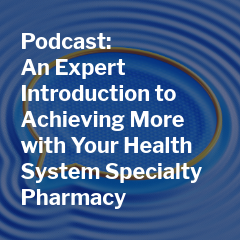
The first in a series of interviews with our Specialty Pharmacy Enablement expert, Ginger Thorpe, covering important questions health systems should be asking.
Six practical insights and questions to help navigate the ambulatory pharmacy environment.
By
Date
June 02, 2021

By Andrew Wilson and Heather Easterling
Read time: 4 minutes
Hospitals participating in the 340B Drug Pricing Program can reduce their costs for drug acquisition — an advantage that appears to enhance business performance while supporting outreach and care for uninsured and underinsured patients. Although acquiring drugs at lower costs can provide a financial benefit to 340B hospitals, the complexities of the ambulatory pharmacy environment require thoughtful planning and responsive adaptability to ensure success.
Here are six questions that could help you effectively manage your ambulatory and specialty 340B program guidelines:
1. How does your hospital’s plan align with your ambulatory and specialty pharmacy strategy?
340B can improve the financial performance of a solid proposal, but it will not rescue a poorly planned pharmacy strategy. Understanding the hospital’s plan for continuing care, patient volumes and provider relationships while aligning them with costs and services is a key success factor. It is also important to examine provider relationships and competition from others in your service area.
Some hospitals and health systems tend to think that they “own” patients, but will the network of relationships within the IDN retain access to these patients in the future, and if so, under what terms? Health plans, employers and other providers also have substantial ongoing patient relationships. How will your patients select a provider, and under what rules and guidelines?
2. What do the terms “ambulatory” and “specialty” pharmacy mean to your organization?
Specialty, ambulatory and retail pharmacy are areas that blend together. Key attributes of specialty pharmacy include high-cost treatments for rare or uncommon diseases that have special development, handling, administrative and monitoring requirements. Retail pharmacy is generally the mix of brand and generic oral solid drugs dispensed in 30-, 60- and 90-day supplies. Ambulatory pharmacy commonly falls across the two categories and typically includes “in-clinic” and “in-office” administered drugs.
Because of these differences, payment rules and models vary. For the specialty space, competencies and certifications mean more potential revenue, whereas low cost and high efficiency are the greatest value in the retail environment.
3. Are you prepared for the competitive retail and specialty pharmacy environment?
The consolidation and competition experienced by hospitals are also attributes of retail and specialty pharmacy. For example, payers and manufacturers seek to narrow networks to contain administrative and patient-care costs and to foster competition. Before entering the mature retail or specialty marketplace, determine if your pharmacy is prepared to compete with the national market leaders. Network size combined with key provider and network agreements, lower cost and efficient operations makes them formidable competitors. In the ASHP Foundation Pharmacy Forecast for 2018, many surveyed pharmacy leaders believed there was potential that 25% of health systems will abandon plans or discontinue current retail/specialty pharmacy services due to financial challenges associated with these service lines. This trend reinforces the value of solid business and strategic planning.
Although 340B provides a cost advantage in drug acquisition, how much of that savings will be consumed by the cost of operations? 340B discounts, while generous, are tied to the average manufacturer price (AMP) and are not consistent across therapies. Consider the impact of new therapies on your bottom line. For instance, recent advances in oral oncology therapy have had a positive impact on patient outcomes. However, high drug pricing has proven to be a challenge for the payer and reimbursement communities, making access and delivery of these specialty drugs difficult at times.
4. Will potential changes in 340B or prescription reimbursement rules affect your business?
Business plans that depend on 340B discounts should consider the potential risks and alternative outcomes associated with changes in 340B and reimbursement rules. Narrowed patient definition, 340B eligibility or even a changed business relationship with a key group of providers can influence the 340B/non-340B patient mix. For hospitals subject to the GPO prohibition, non-340B drugs are purchased at full wholesale acquisition cost (WAC), which can result in a substantial premium.
5. Do you have the right tools and resources to be successful?
Hospital pharmacists typically comment on the key differences and new challenges in the ambulatory environment such as developing and securing talent, resources and competencies. However, it is also critical to assess payer and provider relationships, contracts, and software tools like retail pharmacy systems and 340B software.
Other things to consider:
6. Is a partnership or contract pharmacy right for your organization?
Financial planning can help set appropriate expectations and facilitate a full understanding of the likelihood for success — including 340B impact. Traditional and specialty pharmacies are in some key respects similar, but require separate considerations, particularly in services and support. Financial modeling should lead to a review of ramp-up periods, budgeting for capital assets and cash flow, and a frank discussion of alternatives. 340B provides a head start for financial and patient-care success, but only when built on sound strategies informed by targeted insights.
To learn how McKesson can help your health system or hospital pharmacy, contact us.
Surveyed pharmacy leaders believed there was potential that 25% of health systems will abandon plans or discontinue current retail/specialty pharmacy services due to financial challenges associated with these service lines.